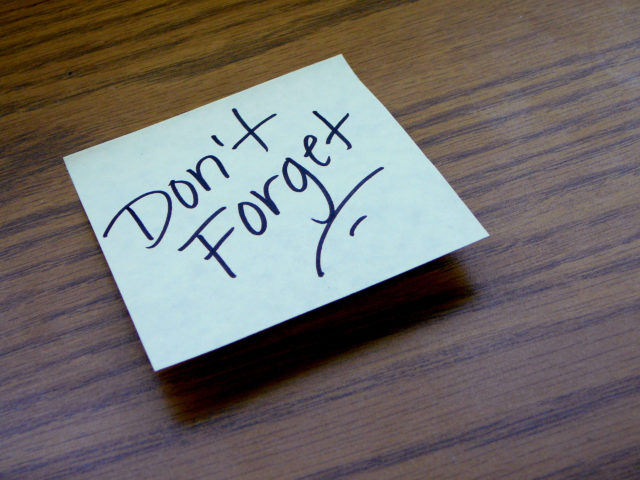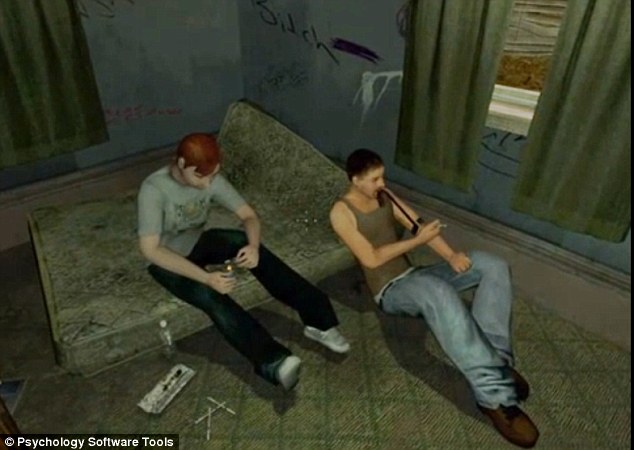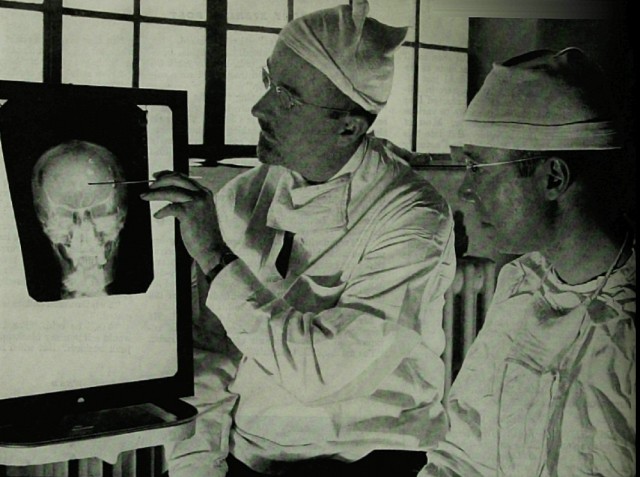Want to hear a depressing statistic? 23.5 million Americans are addicted to drugs and alcohol. Now just imagine how many people worldwide struggle with substance abuse, food cravings and internet addiction. As a people, we’ve tried just about everything to help others (and ourselves) kill the cravings. Here are some of the stranger methods we’ve come up with.
10. The Pavlov Poke
If you’ve ever spent an hour or five on Facebook, you know how addictive social media sites are. Robert R. Morris and Daniel McDuff certainly do. These two PhD candidates at the MIT Media Lab were spending more time online than working on their dissertations, so they decided to rig up a system that’d make Pavlov proud.
The Pavlov Poke was a truly shocking invention. This evil device delivered an unpleasant jolt of electricity whenever Morris or McDuff spent too much time on Facebook. Using a UI inspector to keep track of their Internet usage, the researchers were greeted with an onscreen warning whenever they were on Facebook for too long. And that’s when things got painful. An Arduino plugged into the computer’s USB fired up the shock circuits, sending an electric current through two strips placed on their keyboard rest. The results were pretty unpleasant.
Unfortunately for Facebook addicts, the Pavlov Poke isn’t available in stores, though you can probably find a friend or two willing to shock you with a cattle prod if they decided you’re spending too much time staring at your Wall.
9. New Memories
Memories are a junkie’s worst friend. The last thing a recovering addict needs is to remember how good it felt to get high. To eradicate those positive associations with drugs, therapists often employ a tactic called “extinction.” During an extinction session, patients are shown images of paraphernalia like syringes — a whole lot of syringes. However, the addict never sees the needles being used to inject heroin. The idea is that eventually patients will stop associating syringes with drugs, breaking the desire to shoot up.
Of course, memories are persistent devils, and sometimes extinction by itself isn’t good enough. However, if scientists coupled extinction with a real-life form of inception, perhaps they could remold the addicts’ memories. Researchers from China’s Peking University did just that, showing a group of recovering heroin users movies meant to awaken memories of drug use. This is because, when people try to remember the past, the brain has to “reactivate” our old memories. During that brief time period, our thoughts are very plastic and can easily be reconstructed. So immediately after the movie, the patients underwent an extinction session.
As therapists broke the association between syringes and shooting up, the users subconsciously rebuilt their own memories. As their thoughts “hardened” again, the patients no longer found themselves connecting smack with pleasure. They’d essentially tricked their own minds and rewritten their past. Six months later, they’d totally rewired their brains and weren’t experiencing cravings like before. It was a cure that would’ve made Christopher Nolan proud.
8. Tetris
Released in the USSR in 1984, Tetris is one of the simplest and most frustrating games on the planet, and PhD student Jessica Skorka-Brown of Plymouth University believes it can help people overcome their desire for nicotine, food, and alcohol.
When people crave something such as a cigarette, they picture the object and think about how satisfying it would be to take a drag. Despite their best efforts to resist, they eventually cave into their cravings. However, Skorka-Brown and her colleagues believe if something interrupted that visualization, then people could take control and fight off their unwanted desires. She believes that if people spend as little as three minutes playing Tetris, it’d distract them from their crazy cravings.
To test her theory, she engineered an experiment involving volunteers with unmanageable urges. After taking a survey where they indicated their level of cravings, the participants sat down to play Tetris. However, only half of the games actually worked; the other half were “loading” the entire time. After three minutes was up, Skorka-Brown interviewed the test subjects, and found the folks who played Tetris reduced their cravings by 24% (as opposed to the control group). So the next time you “need” a bite of chocolate or a puff on that cigarette, turn on your computer and start playing video games.
7. Virtual Reality
Imagine you’re a recovering addict. You’re at a party when someone offers you a hit. Suddenly, your body is wracked with cravings. Don’t worry though — this is all part of your treatment. You’re in a virtual world, and your therapist is coaching you through every step.
Scientists are hoping to make therapy a little more realistic with the use of virtual reality. Thanks to new technology, recovering users are placed in a digital world where they’re forced to deal with their demons. The amazing thing about this VR cure is that the world can be rebuilt specifically for each patient. So if an alcoholic associates a certain bar with getting drunk, scientists can recreate that exact bar. They can also engineer crack houses, neighborhoods, and homes, and fill them with various drugs, drinks, and paraphernalia, all tailor-made for each patient.
When the user confronts a tempting scenario, the scientist tells him to let the craving pass through him “like a wave.” Since there’s no real risk the patient can actually take the drug, he’s forced to overcome his desires. As the craving fades, the scientist plays a series of bleeps and beeps, similar to the sound of dialing a phone. Eventually, the patient will associate these weird tones with a feeling of relief so when he’s in a real-world situation, he can call a special number and listen to those exact noises, which will hopefully give him the courage to just say no.
6. Online Assassins
Mr. Feng was not a happy man. His 23-year-old son, Xiao, was a serious video game addict. Instead of looking for a job, Xiao Feng spent every minute of his life playing RPGs online. Mr. Feng told his son he needed to have a career, but the man was more concerned with battling online baddies. Frustrated, the father decided to take the law into his own hands and hire assassins … cyber assassins, that is.
Part gamers, part hitmen, these “online hunters” were paid to eliminate Xiao Feng’s character again and again. and again. Mr. Feng hoped the constant murders would make his son throw down his mouse in disgust and finally step away from the computer. And for a while, it seemed to be working — every time Xiao Feng respawned, the snipers were there, waiting to pick him off. It was so constant, in fact, that Xiao eventually realized something as up. He finally survived long enough to confront his killers, who admitted they were contract killers working for his dear old dad. Furious, Xiao confronted his dad, denied that he was addicted to anything, and insisted that he’d get a job when he found one right for him. With the plan in tatters, father and son patched things up and went on living their lives, one in the real world and the other in a virtual one.
5. Hallucinogenic Drugs
Fearing for their lives, many heroin junkies have turned to a hallucinogenic drug that some say is dangerous, while others claim is a miracle cure. This mysterious substance is called ibogaine, an extract from the iboga plant, a shrub used in Gabonese rituals to communicate with the dead.
Ibogaine works by latching onto opiate receptors in the brain which keeps our bodies from craving narcotics. In addition, since ibogaine is a hallucinogen, users experience vivid hallucinations ranging from flying fish to scenes from childhood. Nostalgic memories such as the latter cause addicts to rethink their lives and start anew, after they wake up from a trance several days later, that is.
Ibogaine, as you might imagine, has plenty of possible side effects, such as increasing the chance of cardiac arrest. It’s also illegal in countries like Belgium, France and the US, where it’s listed as a Schedule 1 substance, alongside cocaine and ecstasy. This has forced many addicts to seek treatment in countries like Mexico and South Africa, where folks like Dimitri Mugianis, Jeff Israel and Dr. Anwar Jeewa administer ibogaine on their own. Sure, there’s always the chance you might not survive the trip, but when your only two choices are possible death vs. certain death, you tend to roll the dice a bit more.
4. Comas
Ever wish you could escape all your troubles by curling into a ball and taking a nice, long nap? Well, during the ‘60s and ‘70s, that was standard practice at Chelmsford Hospital. Located in Sydney, Australia, the clinic provided deep sleep therapy for people suffering from addiction, schizophrenia, anorexia and anything else you can think of. According to Dr. Harry Bailey, the man in charge of the program, sleep was the best cure for any ailment, but you had to sleep for a really long time, like two weeks. During this extended rest, a patient’s mind would supposedly “unlearn” all its bad behavior. After a few days of snoozing, the patient would wake up cured and ready to start life anew.
Unfortunately, Bailey hurt far more people than he helped. During the seventeen years Bailey put patients under, 20-80 people died. The staggering amount of deaths was probably thanks to Bailey using enormous amount of barbiturates to knock his clients out. Or it might’ve had to do with how Bailey electrocuted patients in their sleep without giving them muscle relaxers to keep their bodies from flailing about. Many who survived Bailey’s nightmare therapy went on to commit suicide — despite complaints hoever, the government never intervened.
Finally, the majority of Chelmsford doctors said they’d quit if Bailey didn’t close down the deep sleep ward. His killer treatments finally ended in 1979, and Bailey later committed suicide after an investigation revealed his treatments were extremely flawed.
3. Lobotomies
The idea of cutting away at the human brain is one of the most disturbing thoughts imaginable. However, while most people associate the practice with One Flew Over the Cuckoo’s Nest and the 1950’s, lobotomies are still carried out today as a radical way of ending drug dependency.
In 2002, Russian doctors were hacking away at the human head in order to “cure” heroin junkies. The practice involved drilling a small hole in the skull before removing one cubic millimeter of tissue from each side of the brain. Between 1999 and 2002, doctors carved up nearly 335 patients, many of which were “successful”, except for side effects like splitting headaches and loss of sanity.
Eventually, the government ended these horror shows, but the practices live on in China. Technically, Chinese lobotomies were outlawed in the early 2004, but some doctors still carry out the technique in the name of research. As of 2012, over one thousand addicts underwent a terrifying procedure that involved burning cells in the nucleus accumbens. This is the part of the brain that releases dopamine, the pleasure-releasing chemical. By torching a few of these cells, scientists hope to kill the junkie’s cravings, but they risk wiping out a person’s ability to feel any sort of pleasure at all.
Sadly, the success rate for these surgeries is very low while negative side effects are very high. While the ethics are debatable, the practice does raise an interesting question: is it worth erasing your humanity to beat a crippling addiction?
2. Beatings
Dr. German Pilipenko and Prof. Marina Chukhrova are psychologists with a firm belief that if a junkie comes along, you must whip him, whip him good. The duo run a clinic in Siberia where addicts are beaten on a regular basis. People struggling with booze, narcotics, or even work and sex addiction will pay 3,000 rubles ($99) to strip off their clothes and lie face down on Pilipenko’s surgical table. Then an opposite-sex medic shows up, armed with a willow switch. The punishment professional then starts whacking the client on the buttocks, giving sixty spankings to drug users and thirty to everybody else.
While this might seem pretty kinky to most of us, Dr. Pilipenko swears it’s strictly scientific. The good doctor claims whippings release endorphins or “happiness hormones” as he calls them. These chemicals help patients feel better, more relaxed, and full of “enthusiasm for life.” In addition to providing joie de vivre, the canings are supposed to help junkies deal with the stress that drives their addictions. Besides, Pilipenko claims, the whole process is heavily regulated. Clients receive examinations beforehand to make sure they can withstand a beating, and addicts receive counseling before and each session to help them overcome their dependency. Whether there’s a sexual component or not, you can definitely say that the occasional rod to the tush sure beats addiction.
1. Internet Addiction Camps
Despite a love affair with censorship, China has over 300 million Internet users, many of whom are highly addicted. Instead of standing idly by while kids spend all their time online, the government has sponsored a series of Internet boot camps, with mixed results.
Parents who feel their teens are junkies can enroll them in Internet addiction camp, like the one run by Colonel Tao Ran in Beijing. For three months, kids (and their parents, since Ran believes Internet addiction stems from bad parenting) are forbidden access to computers and cell phones. They wake up at 6:30 AM, perform military drills, undergo counseling, read actual books, and play sports until bedtime at 9:30 PM.
The success of camps like Ran’s are causing the idea to spread all across Asia. In 2013, Japan announced they too would start “Internet fasting camps” in attempts to crush addiction there. Hopefully, their approach is more like Ran’s and less like some of his downright brutal competition. One such camp punished rule breakers with electroshock therapy, and in 2009, three instructors beat a sixteen-year-old boy to death in Nanning. These tragedies definitely put a dark spin on the camps and, sadly, give less-sadistic camps a bad reputation.









